Bipartisan Bill Makes Progress on Modernizing Our Energy Infrastructure, an Economic Imperative
Statement by Sen. Cantwell
WASHINGTON, D.C. – July 29, 2015 – (RealEstateRama) — U.S. Senator Maria Cantwell (D-Wash.), ranking member of the Senate Energy and Natural Resources Committee, gave the following statement during a business meeting to debate and vote on bipartisan energy legislation.
“Bolstering the reliability, resilience and affordability of our electricity infrastructure has become a major economic imperative,” Sen. Cantwell said. “Making progress requires a strategy, given the fragmented way the electric grid is owned, operated and regulated. And that’s where this bill comes into play.”
Read her full statement below:
“Thank you, Madam Chairman, for your work and leadership here.
“Many people know that we started this year with a full focus on energy policy in January. But what they probably don’t know is that we continued to meet every week since then to talk about energy policy. That’s why we are here today. I wanted to thank the staffs from both the majority and minority for their hard work on getting us to this point today, and all of the staffs from members on both sides of the aisle for their work in support of this legislation. It’s no secret that whenever you try to take into consideration in energy policy, everywhere from West Virginia to Hawaii, or from Louisiana to Maine, you are going to have some differences of opinion about what should be the priority. So again I thank all of our colleagues for trying to make this the best bipartisan legislation that we could have today.
“The legislation before us today represents this committee’s first attempt to craft broad, bipartisan energy legislation since 2009. The chairman and I agreed in the opening days of Congress that it was important for us to address the emerging energy policies that are important for our country. Every day, somewhere in the country, we experience the effects of extreme weather, climate change or cyber threats to our aging infrastructure.
“So we decided that we needed to make sure that we were moving forward on energy legislation that would help our country. In fact, since our last energy bill in 2007, the U.S. energy landscape has changed dramatically. Wind power capacity has more than tripled, solar PV installations are up nearly 15 times, and the number of LED lights in the U.S. has grown more than ninety times, to nearly 34 million LED lights by the end of 2013. Thanks to the use of more LEDs, the U.S. Department of Energy estimates that Americans will save over $30 billion a year in electricity costs and cut America’s energy consumption for lighting in half by 2030. Not all these things happen because of policy, but the policies that we implemented along the way helped moved this transition along.
“The Quadrennial Energy Review, which we had a hearing on recently, laid out the challenges that we face on energy security moving forward very clearly. It’s true that we have had substantial progress in driving down costs of these low-carbon, end-use energy technologies. But it’s also the case that we need to do more to break through barriers to integrating these new technologies into our legacy energy infrastructure. It’s clear that in order to stay competitive globally, we must modernize the U.S. electric grid, particularly as our economy transitions to one in which data-intensive industries and information technologies drive our growth. Bolstering the reliability, resilience and affordability of our electricity infrastructure has become a major economic imperative.
“Making progress requires a strategy, given the fragmented way the electric grid is owned, operated and regulated. And that’s where this bill comes into play. As clearly called out in the Quadrennial Energy Review, we have to make investments in our energy infrastructure – not just in grid modernization, but the rest of the energy infrastructure. I have come to believe that our energy infrastructure is almost like clogged arteries – particularly when it comes to the fact that even energy commodities compete with each other to try to get access to market. To say nothing of the fact that agriculture products get pushed off the rails because of energy products.
“Our bipartisan efforts here are to try to address these challenges in six particular areas: (1) energy storage, (2) modernizing our grid, (3) cybersecurity, (4) the energy workforce, (5) the Strategic Petroleum Reserve and (6) the Land and Water Conservation Fund.
Energy Storage
“In the bill, we look at developing cost-effective energy storage technologies, tailored to the electric grid. We have heard witnesses before this committee comment on the game-changing nature of energy storage technology. It is key to bolstering resilience and integrating more diverse resources into the grid. We’ve taken testimony on proposals from Sen. Franken, Sen. Heinrich, Sen. King and Sen. Wyden on this topic. And we have tried to implement the best ideas. 6.3 gigawatts – that is three times the capacity of Hoover Dam – is needed in the west in the next 15 years. So investing in storage will help us meet this emerging market demand for energy.
Modernizing Our Grid
“Second, we need to modernize our grid and accelerate the transition to a more distributed and resilient electric grid. We took in compelling testimony from many people about this topic, and we have included language from my colleagues the Senator from Maine and Senator from Hawaii on this topic of the importance of distributed generation and microgrids. To help accelerate this transition, we have put language in the bill that will really help us on demonstrations, microgrid deployment and performance metrics. Because we have implemented some of this in the Pacific Northwest already, the distributed technologies have demonstrated a 15 percent peak electricity reduction and a 10 percent consumer cost savings. We want to continue to invest in this area.
Cybersecurity
“On the issue of cybersecurity, there probably isn’t a day that goes by that we don’t hear of the threats. In fact, 56 percent of cyber incidents reported to DHS in 2013 were directed at critical energy infrastructure, mostly toward the electric grid–and that’s a number that continues to grow. So for the first time, this bill formalizes the Department of Energy’s role as the ‘Sector-Specific Agency’ for coordinating cyber response within the energy sector. And it means we must do more in cyber-related research and development, supply chain security and public-private partnerships for information-sharing, to better protect the public and parts of our economy that are so dependent on the electric grid.
The Energy Workforce
“This legislation also calls for an investment in workforce. Some 55 percent of the energy workforce is expected to retire in the next decade. In fact, over the next 15 years, the energy sector will need to replace 2 million workers and hire an additional 1.5 million workers for new jobs. The good news is that the United States can be a leader in these new technologies, but there are lots of jobs to fill.
“We need to stay ahead of the curve and make investments in job training through our community colleges and registered apprenticeship programs that will help us do that.
Strategic Petroleum Reserve Modernization
“Strategic Petroleum Reserve (SPR) – a subject that has gotten a lot of attention of late – is under a tremendous amount of pressure to make sure that we make new investments. This bill reasserts the fundamental purpose of the Strategic Petroleum Reserve, which is our most important federal energy security asset. The Quadrennial Energy Review lays this out very specifically and analyzes the energy security value of the SPR and ways to maximize its value for the taxpayers. While we have had other legislation looking at using SPR money for infrastructure investments, I hope this committee will lock arms on the need to make sure that SPR resources are used to help the distribution of our products.
“After all, the Department of Energy did a test sale in 2014 and identified a series of challenges in how the SPR distribution actually works. So we shouldn’t be in a position where actually we have an emergency and can’t get the SPR to work effectively. And that’s why we need to redouble our efforts to make sure we make an investment in this.
Permanent Extension of the Land and Water Conservation Fund
“Lastly, it’s no secret the value the Land and Water Conservation Fund. It’s expiring in September. We need to get this done. I hope colleagues will support this provision as a way to continue to make progress on preserving some of our most important areas and continue with other provisions in the bill, like improving hydro relicensing.
“I know that my colleagues want to offer many amendments to this legislation that could become poison pills. We’ve tried to take into consideration both sides of the aisles’ interests in crafting in what is bipartisan legislation. Our hope is that this bipartisanship will carry us to the Senate floor and allow us to get these energy policies not only through this committee, but through the Senate. I thank the chair for her hard work and leadership. And I look forward to getting this bill out of committee.”














